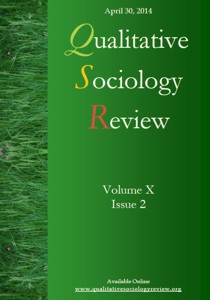Our Family Functions: Functions of Traditional Weddings for Modern Brides and Postmodern Families
DOI:
https://doi.org/10.18778/1733-8077.10.2.04Keywords:
Weddings, Bride, Marriage, Tradition, RitualAbstract
In many ways the continued popularity of traditional weddings in the United States may seem surprising in light of the increased rates of divorce, cohabitation, and non-marital child-bearing in the latter half of the twentieth century, which have accompanied the rise of what has come to be called the “postmodern” family. This research draws upon in-depth interviews with twenty white, middle class women who recently had traditional weddings and explores the connections between the postmodern family context and the desirability of traditional weddings. Specifically, it examines how traditional functions of formal weddings are still relevant within contemporary society. Findings indicate that the traditional functions of weddings operate differently in the current family context, but are important aspects of the appeal of formal weddings for modern brides. Large, formal weddings encourage extended family bonding, which may be more important now than in past decades due to the high rates of divorce and remarriage. New “invented traditions” are sometimes being included in weddings to allow for the participation of the wider range of family members that exists in post-modern families. Furthermore, having a large, traditional wedding may serve to decrease anxiety about marriage through providing a predictable entry into marriage and a testing ground for the couple’s marital work ethic.
Downloads
References
Ahrons, Constance. 2004. We’re Still Family: What Grown Children Have to Say About Their Parents’ Divorce. New York: HarperCollins.
Google Scholar
American Community Survey. 2010. “Median Age at First Marriage.” Retrieved July 20, 2012: http://factfinder2.census.gov/faces/tableservices/jsf/pages/productview.xhtm-l?pid=ACS_10_3YR_B12007&prodType=table
Google Scholar
Bramlett, Matthew D. and William D. Mosher. 2002. “Cohabitation, Marriage, Divorce and Remarriage in the United States.” National Center for Health Statistics. Vital Health Statistics 23(22). Retrieved June 14, 2012: http://www.cdc.gov/nchs/data/series/sr_23/sr23_022.pdf
Google Scholar
Castrén, Anna-Maija and Florence Maillochon. 2009. “Who Chooses the Wedding Guests, The Couple, Or The Family? Individual Preferences and Relational Constraints in France and Finland.” European Societies 11(3):369-389.
Google Scholar
DOI: https://doi.org/10.1080/14616690902764724
CDC/NCHS National Vital Statistics. 2013. “National Marriage and Divorce Rate Trends: Provisional number of marriages and marriage rate: United States, 2000-2011.” Retrieved July 22, 2013: http://www.cdc.gov/nchs/nvss/marriage_divorce_tables.htm
Google Scholar
Cherlin, Andrew J. 2004. “The Deinstitutionalization of American marriage.” Journal of Marriage and Family 66:848-861.
Google Scholar
DOI: https://doi.org/10.1111/j.0022-2445.2004.00058.x
Cherlin, Andrew J. 2010. The Marriage-Go-Round: The State of Marriage and the Family in America Today. New York: Vintage Books.
Google Scholar
Cohen, Philip. 2013. “Marriage is Declining Globally: Can You Say That?” Family Inequality Blog. Retrieved July 22, 2013: http://familyinequality.wordpress.com/2013/06/12/marriage-is-declining/
Google Scholar
Currie, Dawn H. 1993. “Here comes the Bride”: The Making of a ‘Modern Traditional’ Wedding in Western Culture. Journal of Comparative Family Studies 24(3):403-422.
Google Scholar
DOI: https://doi.org/10.3138/jcfs.24.3.403
Edin, Kathryn and Maria Kefalas. 2007. Promises I Can Keep: Why Poor Women Put Motherhood before Marriage. Berkeley, Los Angeles, London: University of California Press.
Google Scholar
Glaser, Barney and Anselm L. Strauss. 1967. The Discovery of Grounded Theory. Chicago: Aldine.
Google Scholar
Goffman, Erving. 1967. Interaction Ritual: Essays on Face-to-Face Behavior. New York: Anchor Books.
Google Scholar
Hackstaff, Karla B. 1999. Marriage in a Culture of Divorce. Philadelphia, PA: Temple Press.
Google Scholar
Hobsbawm, Eric. 1983. “Introduction: Inventing Tradition.” Pp. 1-14 in The Invention of Tradition, edited by Eric Hobsbawm and Terence Ranger. Cambridge: Cambridge University Press.
Google Scholar
DOI: https://doi.org/10.1017/CBO9781107295636.001
Howard, Vicki. 2006. Brides, Inc. American weddings and the business of tradition. Philadelphia, PA: University of Pennsylvania Press.
Google Scholar
Ingraham, Chrys. 2008. White Weddings: Romancing Heterosexuality in Popular Culture. 2nd ed. New York: Routledge.
Google Scholar
Krefting, Laura. 1999. “Rigor in Qualitative Research: The Assessment of Trustworthiness.” Pp. 173-181 in Cases in Qualitative Research: Research Reports for Discussion and Evaluation, edited by Andrea K. Milinki. Los Angeles, CA: Pyrczak Publishing.
Google Scholar
LaRossa, Ralph. 2005. “Grounded Theory Methods and Qualitative Family Research.” Journal of Marriage and Family 67:837-857.
Google Scholar
DOI: https://doi.org/10.1111/j.1741-3737.2005.00179.x
Lewin, Ellen. 1998. Recognizing Ourselves: Ceremonies of Lesbian and Gay Commitment. New York: Columbia University Press.
Google Scholar
Mead, Rebecca. 2007. One Perfect Day: The Selling of the American Wedding. New York: The Penguin Press.
Google Scholar
Merton, Robert K. 1968. Social Theory and Social Structure. New York: Free Press.
Google Scholar
Nett, Emily. 1988. Canadian Families Past and Present. Toronto: Butterworths.
Google Scholar
Otnes, Cele C. and Elizabeth H. Pleck. 2003. Cinderella Dreams: The Allure of the Lavish Wedding. Berkeley, CA: University of California Press.
Google Scholar
DOI: https://doi.org/10.1525/california/9780520236615.001.0001
Pew Research Center. 2012. “‘Nones’ on the Rise: One-in-Five Adults Have No Religious Affiliation.” The Pew Forum on Religion and Public Life. Retrieved November 15, 2012: http://www.pewforum.org/files/2012/10/NonesOnTheRise-full.pdf
Google Scholar
Pleck, Elizabeth. 2000. Celebrating the Family: Ethnicity, Consumer Culture and Family Rituals. Cambridge, MA: Harvard University Press.
Google Scholar
Reaney, Patricia. 2012. “Average Cost of U.S. Wedding Hits $27,021.” Retrieved July 15, 2013: http://www.reuters.com/article/2012/03/23/us-wedding-costs-idUSBRE82M11O20120323
Google Scholar
Rothman, Ellen K. 1984. Hands and Hearts: A History of Courtship in America. New York: Basic Books.
Google Scholar
Small, Mario Luis. 2008. “Lost In Translation: How Not to Make Qualitative Research More Scientific.” Pp. 1-8 in Report from Workshop on Interdisciplinary Standards for Systematic Qualitative Research, edited by Michèle Lamont and Patricia White. Washington, DC: National Science Foundation. Retrieved December 15, 2013: http://home.uchicago.edu/~/mariosmall/OldSite_October13/documents/Lost.pdf
Google Scholar
Stacey, Judith. 1990. Brave New Families. New York: Basic Books.
Google Scholar
The Wedding Report. 2012. Retrieved July 18, 2013: http://www.theweddingreport.com/
Google Scholar
Turner, Victor. 1969. The Ritual Process: Structure and Anti-Structure. Chicago: Aldine Publishing.
Google Scholar
Weiss, Robert S. 1994. Learning From Strangers: The Art and Method of Qualitative Interview Studies. New York: Free Press.
Google Scholar
Whyte, Martin K. 1990. Dating, Mating, and Marriage. Hawthorne, NY: Aldine de Gruyter.
Google Scholar
Young, Michael and Peter Willmott. 1957. Family and Kinship in East London. London: Free Press.
Google Scholar
Downloads
Published
How to Cite
Issue
Section
License

This work is licensed under a Creative Commons Attribution-NonCommercial-NoDerivatives 4.0 International License.











